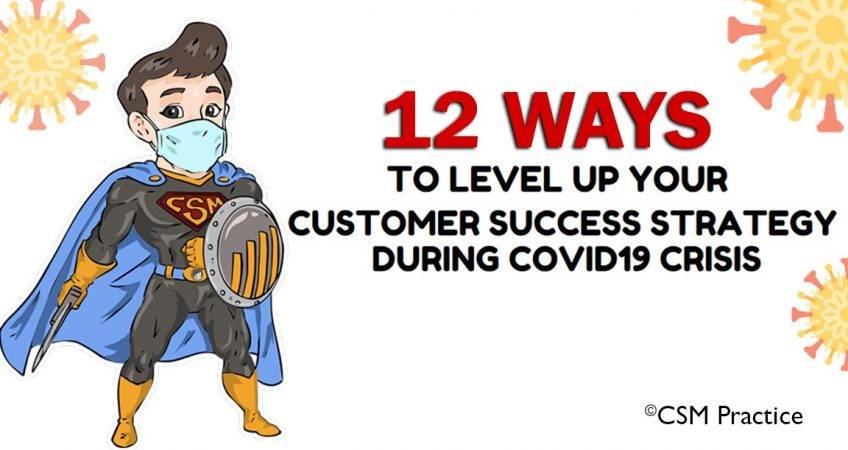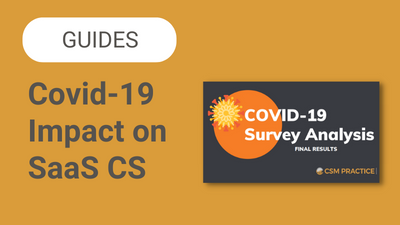The economic crisis has affected Customer Success teams all over the world, without exceptions. Dealing with the new reality required customer success leaders to step up and revise their existing customer strategies to meet the overflow of customer requests for cash flow relief, QBR meeting cancellations, as well as lay-offs on both ends.

During this crisis, we’ve been surveying customer success organizations and executive roundtables on a weekly basis, to better understand current trends, challenges, and most importantly – initiatives and strategies that favorably impacted customer success managers’ ability to stay relevant and effective during the pandemic.
Leveraging our experience working with customer success teams during this crisis as well as our survey and research results we developed a simple infographic to offer a number of practical and easy ways you can augment your customer success strategy to better adjust to the new norm:
Set up a hotline for customer care. By answering customers’ queries quickly, customer success teams can offer an appropriate customer experience that fosters stronger partnerships with clients in a time of crisis. Take the time to develop a communication plan on how to respond to customer cash relief asks, based on industry and size. Be agile! It’s important to get answers fast and develop your communication plan quickly, versus getting it perfect.
Develop customer surveys to capture stakeholders’ and client’s feedback. Instead of sending out generic NPS surveys, consider leveraging customized customer surveys to surface customer feedback and relevant insights related to their current needs. Translate the survey responses into actionable ideas to develop customer success plays and solutions to effectively address the challenge at hand in a customer-centric manner. Asking your customers for feedback now will help demonstrate your organization’s commitment to taking care of your end-users and decision-makers during this crisis.
Prioritize customers after adjusting your customer health score. To retain customers and continue to create opportunities with them, it is significant to revisit your customer health score as a tool to prioritize customers during the crisis. Follow these steps to implement this approach:
- Are end-users able to use your solution(s) frequently during a crisis?
- How much value can your product contribute to helping your customers deal better with the new reality?
- What is the sentiment of value each customer has towards your solutions?
- Is the customer-serving industries that were heavily impacted by the pandemic? Positively or negatively?
- How recent was your touchpoint with the decision-maker? With the admin? End-user?
- Is their renewal date fast approaching?
- Have they recently asked for cash flow relief or submitted a request to cancel/minimize their subscription?
Focus on your customers. Proactively reach out to your customers and ask how are they doing. How is their family doing? Is there anything you can do to help? Your customer’s well-being and mental health should become your priority. Offer free resources where appropriate and introductions to your personal network for your customer stakeholders who are currently risking of losing their job or in the midst of securing a new client. This will lead to a long-lasting partnership and a great success story.
Adjust your CX and CS programs. We are in uncharted waters and learn new things about the pandemic day in and day out. Your customer experience data (such as NPS and online reviews) might be skewed. Consider isolating these results and focusing your insights on helping the organization understand the current situation at hand and how to respond to it.
Take a break from your usual CS metrics. For a moment, ignore your usual metrics. Your renewal forecast is likely useless at this point. Your customer usage levels – irrelevant. The current reality impact on our clients and employees caused a large scale of disruptions in data collection. This can make analyzing trends based on historical data not that reliable. Consider isolating data trends for the next quarter (at least), and focus on what is currently happening, using the shelter-in milestone as your cut-off date.
Establish constant communication with the customers on the company’s status. Be transparent and give company updates to customers and stakeholders about what is happening in the business during this economic crisis. You can do this through a live webinar, collateral, and campaigns, newsletter, etc. Make them feel that your company is there for them.
Free service offerings. This pandemic changed many things, but it also opened windows of opportunities when it comes to marketing activities. Offer free services, content, or access to other resources on your company’s website. This will encourage loyalty from existing customers and invite new prospects to try your product and services. It will also (for a moment) divert their attention from the crisis and focus them on proactive measures they can take. You’re not only offering free services, but you’re also offering a positive impact.
Create flexible payment options. Customers might be facing difficult times during the crisis, some customers face financial difficulties, while most lost their jobs or businesses. Help customers by adjusting your payment options. Creating additional payment options that fit your customers’ current situation reduces the financial burdens your customers face in the short run and will make them feel that your company understands.
Listen. Listen. Listen. Customer success managers and other customer-facing teams should be more attentive to customer questions to capture their new goals. In such a fluid situation, the knowledge base should be updated often with new customer questions. SaaS businesses must also be prepared to make quick changes to their offering in favor of customer needs as we navigate these uncertain times. Keep in mind that customers can be a source of new ideas, and acting on their comments makes them feel more valued.
Consider adjusting your subscription model. Customer behavior is critical right now. Use this opportunity to change or adjust your subscription model to get new sets of clients or to promote upsell. Study what’s in. Study what currently works for your customers and use it to attract new clients.
Embrace Social Responsibility. Show the purpose behind your brand. Fighting this pandemic is a joint responsibility of every organization, the government, and every citizen. This is the best time to help one another as everyone is affected all around the globe. Give back to the community, and see what you can do to ease the impact of the new economic situation on our society. Consider opening a dedicated Slack channel for your end-users or executive decision-makers to help them share best practices on topics like working remotely, and balancing work.
Key Takeaway
Nobody knows when exactly the crisis will end, in the following months, it might get better or worse. As customer success managers, we have the opportunity to take this as a challenge to step up and improve our strategies toward Customer Success.















